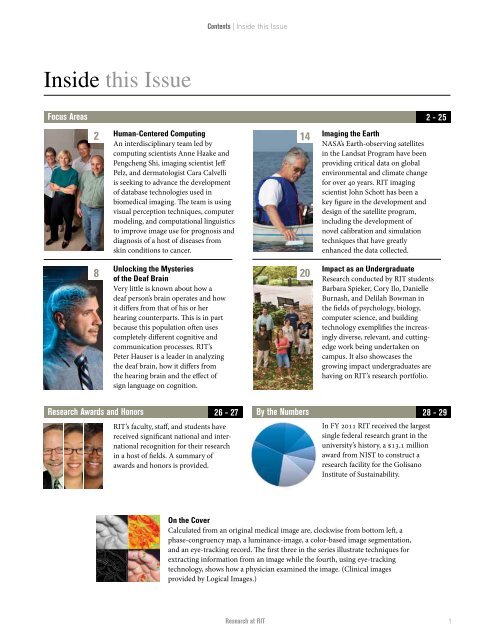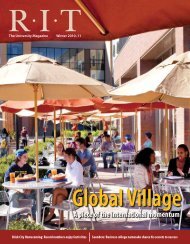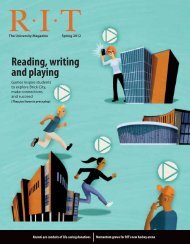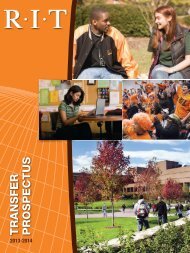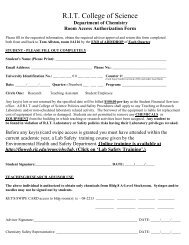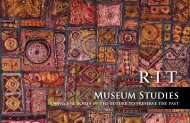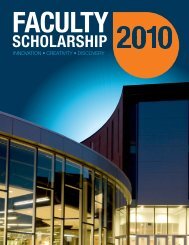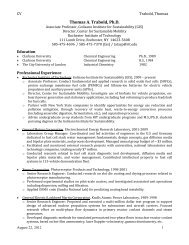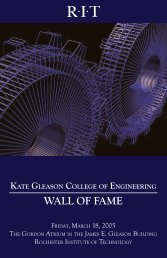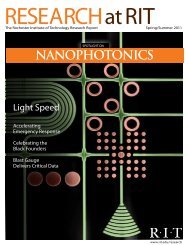Fall / Winter 2012 - Rochester Institute of Technology
Fall / Winter 2012 - Rochester Institute of Technology
Fall / Winter 2012 - Rochester Institute of Technology
You also want an ePaper? Increase the reach of your titles
YUMPU automatically turns print PDFs into web optimized ePapers that Google loves.
Contents | Inside this Issue<br />
Inside this Issue<br />
Focus Areas<br />
2 - 25<br />
2<br />
Human-Centered Computing<br />
An interdisciplinary team led by<br />
computing scientists Anne Haake and<br />
Pengcheng Shi, imaging scientist Jeff<br />
Pelz, and dermatologist Cara Calvelli<br />
is seeking to advance the development<br />
<strong>of</strong> database technologies used in<br />
biomedical imaging. The team is using<br />
visual perception techniques, computer<br />
modeling, and computational linguistics<br />
to improve image use for prognosis and<br />
diagnosis <strong>of</strong> a host <strong>of</strong> diseases from<br />
skin conditions to cancer.<br />
14<br />
Imaging the Earth<br />
NASA’s Earth-observing satellites<br />
in the Landsat Program have been<br />
providing critical data on global<br />
environmental and climate change<br />
for over 40 years. RIT imaging<br />
scientist John Schott has been a<br />
key figure in the development and<br />
design <strong>of</strong> the satellite program,<br />
including the development <strong>of</strong><br />
novel calibration and simulation<br />
techniques that have greatly<br />
enhanced the data collected.<br />
8<br />
Unlocking the Mysteries<br />
<strong>of</strong> the Deaf Brain<br />
Very little is known about how a<br />
deaf person’s brain operates and how<br />
it differs from that <strong>of</strong> his or her<br />
hearing counterparts. This is in part<br />
because this population <strong>of</strong>ten uses<br />
completely different cognitive and<br />
communication processes. RIT’s<br />
Peter Hauser is a leader in analyzing<br />
the deaf brain, how it differs from<br />
the hearing brain and the effect <strong>of</strong><br />
sign language on cognition.<br />
20<br />
Impact as an Undergraduate<br />
Research conducted by RIT students<br />
Barbara Spieker, Cory Ilo, Danielle<br />
Burnash, and Delilah Bowman in<br />
the fields <strong>of</strong> psychology, biology,<br />
computer science, and building<br />
technology exemplifies the increasingly<br />
diverse, relevant, and cuttingedge<br />
work being undertaken on<br />
campus. It also showcases the<br />
growing impact undergraduates are<br />
having on RIT’s research portfolio.<br />
Research Awards and Honors 26 - 27<br />
RIT’s faculty, staff, and students have<br />
received significant national and international<br />
recognition for their research<br />
in a host <strong>of</strong> fields. A summary <strong>of</strong><br />
awards and honors is provided.<br />
By the Numbers<br />
In FY 2011 RIT received the largest<br />
single federal research grant in the<br />
university’s history, a $13.1 million<br />
award from NIST to construct a<br />
research facility for the Golisano<br />
<strong>Institute</strong> <strong>of</strong> Sustainability.<br />
28 - 29<br />
On the Cover<br />
Calculated from an original medical image are, clockwise from bottom left, a<br />
phase-congruency map, a luminance-image, a color-based image segmentation,<br />
and an eye-tracking record. The first three in the series illustrate techniques for<br />
extracting information from an image while the fourth, using eye-tracking<br />
technology, shows how a physician examined the image. (Clinical images<br />
provided by Logical Images.)<br />
Research at RIT<br />
1


